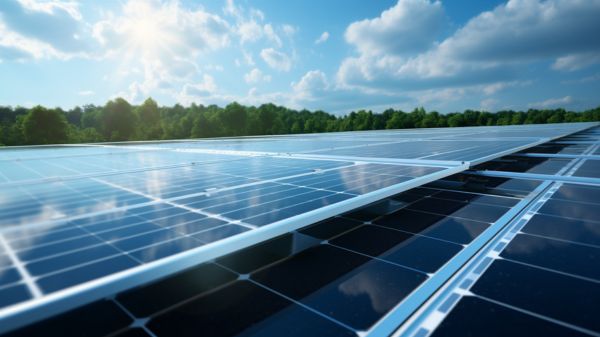Defining Green Energy's Role in Climate Change Mitigation
Are you curious about the role of green energy in mitigating climate change? Look no further.
In this article, we will explore the impact of green energy on climate change and the current challenges and opportunities it presents.
We will also delve into the policies and regulations driving the adoption of green energy, as well as the innovations and technologies shaping its future.
Join us as we uncover the collaborative efforts in green energy and climate change mitigation.
The Impact of Green Energy on Climate Change
Green energy plays a crucial role in mitigating climate change by significantly reducing greenhouse gas emissions.
Renewable energy’s contribution to the reduction of greenhouse gas emissions is well-documented and widely recognized.
The effectiveness of renewable energy in combating climate change stems from its ability to harness natural resources such as sunlight, wind, and water, which are abundant and replenishable.
By relying on these renewable sources, we can minimize our dependence on fossil fuels, which are major contributors to greenhouse gas emissions.
Studies have shown that transitioning to renewable energy sources can lead to a significant decrease in carbon dioxide emissions, thereby slowing down the rate of global warming.
The adoption of green energy technologies is essential to address the challenges posed by climate change and secure a sustainable future for generations to come.
Current Challenges and Opportunities for Green Energy
To continue the discussion from the previous subtopic, you need to tackle the current challenges and opportunities that green energy faces.
One of the key challenges is the need for increased investment incentives to promote the development and adoption of renewable energy technologies. Governments and private investors need to provide financial support and incentives to encourage the growth of green energy projects.
Additionally, there’s a need for robust renewable infrastructure development. This involves the establishment of a reliable and efficient grid system to accommodate the integration of renewable energy sources. It also requires the expansion and improvement of energy storage technologies to address the intermittent nature of renewable energy generation.
Despite these challenges, there are also significant opportunities for green energy, such as the potential for job creation, economic growth, and reduced greenhouse gas emissions. By investing in green energy, countries can’t only mitigate climate change but also create a sustainable and resilient energy future.
Policies and Regulations Driving Green Energy Adoption
The implementation of policies and regulations is crucial in driving the adoption of green energy. In order to promote the transition to renewable energy sources, governments worldwide have introduced a range of incentives and subsidies. These measures aim to incentivize individuals and organizations to invest in green energy technologies and infrastructure.
By offering financial support and tax breaks, governments encourage the adoption of renewable energy systems, such as solar panels and wind turbines. Additionally, policies and regulations are shaped by public opinion, which plays a significant role in driving the demand for green energy. As more people become aware of the environmental consequences of traditional energy sources, the pressure for governments to prioritize renewable energy grows.
Consequently, policies and regulations are continuously being refined and updated to align with public sentiment and support the widespread adoption of green energy technologies.
Innovations and Technologies Shaping the Future of Green Energy
By exploring new innovations and technologies, you can shape the future of green energy and contribute to climate change mitigation. Sustainable infrastructure and renewable investments are key elements in this endeavor.
The development of sustainable infrastructure, such as smart grids and energy-efficient buildings, plays a vital role in optimizing energy usage and reducing carbon emissions. These infrastructures integrate renewable energy sources, such as solar panels and wind turbines, into the existing energy grid, allowing for a more efficient and sustainable energy system.
Additionally, renewable investments in research and development are crucial for advancing green energy technologies. Investments in areas like battery storage, hydrogen fuel cells, and advanced wind and solar technologies are driving innovation and pushing the boundaries of what’s possible in the realm of green energy.
Collaborative Efforts in Green Energy and Climate Change Mitigation
Join forces with other individuals and organizations to tackle climate change by working together on collaborative efforts in green energy and mitigation. Collaborative research and international partnerships are crucial in addressing the challenges of climate change and transitioning to a sustainable future.
By pooling resources, knowledge, and expertise, collaborative efforts can accelerate the development and deployment of green energy technologies and solutions. Through international partnerships, countries can share best practices, learn from each other’s experiences, and coordinate efforts to reduce greenhouse gas emissions. Collaborative research allows for the exploration of innovative ideas and the identification of effective strategies for mitigating climate change.
These collaborative efforts not only foster a sense of belonging and shared responsibility but also maximize the impact of individual actions by creating a collective force for positive change. Together, we can make a significant difference in combating climate change and achieving a greener future.
Conclusion
In conclusion, green energy plays a crucial role in mitigating climate change. However, it faces both challenges and opportunities in its widespread adoption.
Policies and regulations are driving the transition towards green energy, while innovations and technologies are shaping its future.
Collaborative efforts are also instrumental in achieving climate change mitigation goals. But, can we afford to ignore the potential of green energy in addressing the pressing issue of climate change?






